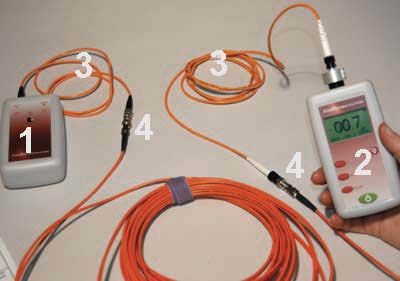All You Need to Find Out About Robotic Vision and Its Applications in Advanced Optical Dimension Solutions
Robotic vision represents a substantial development in the junction of computer vision, expert system, and artificial intelligence. This modern technology boosts the accuracy of optical dimension systems, allowing real-time information analysis and improved high quality control. Its influence extends several industries, from manufacturing to health care. The developing landscape of robotic vision raises questions concerning future capacities and applications. What technologies lie ahead in this transformative area?
Recognizing Robotic Vision: Key Concepts and Technologies
Robotic vision encompasses the innovations and approaches that enable machines to analyze and comprehend aesthetic information from their environment. This area integrates aspects of computer system vision, synthetic intelligence, and artificial intelligence to facilitate automatic decision-making based upon aesthetic data. Key principles consist of picture handling, which includes the improvement and analysis of images to remove meaningful features, and item recognition, which enables devices to recognize and identify objects within a scene.

The Combination of Robotic Vision With Optical Measurement Systems
As industries increasingly require accuracy and efficiency, the assimilation of robot vision with optical measurement systems has become a transformative strategy. This harmony allows robotics to view and translate their surroundings, enhancing the capacity of optical measurement systems to analyze and analyze items with unequaled accuracy. By furnishing optical sensors with innovative imaging innovations, robotic vision makes it possible for real-time information collection and processing, helping with prompt changes to dimension parameters.
The combination equips automated systems to detect variants in measurements, surface high quality, and placement, which are essential in quality control processes. Enhanced algorithms, such as equipment understanding, further increase this assimilation by boosting the systems' capacity to adapt to various settings and situations. The combination not just streamlines measurement processes however likewise lessens mistakes, ensuring that products meet rigid industry requirements, therefore strengthening the duty of robotic vision in the future of optical measurement systems.
Applications of Robotic Vision in Manufacturing
In contemporary production settings, the usage of vision systems has changed production procedures by making it possible for equipments to execute jobs with remarkable precision and speed. Robotic vision systems are significantly utilized for quality assurance, where they inspect items for issues and guarantee adherence to requirements. These systems make use of video cameras and progressed formulas to analyze items in real-time, significantly lowering the threat of human mistake.
Furthermore, robotic vision promotes automation in assembly lines, permitting robots to precisely determine parts and construct them with very little downtime. This technology also improves stock management, as vision systems can check stock levels and detect discrepancies, assuring a smooth supply chain.
Additionally, robotic vision aids in the execution of wise factories, where data from vision systems can be incorporated with various other innovations to optimize process. Overall, the applications of robot vision in producing show its important function in boosting effectiveness, quality, and efficiency throughout numerous sectors
Robotic Vision in Medical Care: Reinventing Patient Care

In rehabilitation, robotic vision help in monitoring person development and tailoring treatment sessions to specific demands. It supports clinical professionals by automating jobs such as information collection and client surveillance, permitting even more time to concentrate on straight individual interaction. Additionally, robot vision improves telemedicine by enabling remote medical diagnosis and digital appointments, connecting the gap in between individuals and health care providers. On the whole, the application of robot vision in medical care is changing client care, bring about enhanced outcomes, performance, and individual fulfillment.
Future Trends and Developments in Robotic Vision Innovation
The rapid evolution of robotic vision innovation guarantees to additionally boost its applications throughout different industries, consisting of healthcare. Future fads show a considerable shift in the direction of incorporating fabricated intelligence and artificial intelligence, allowing systems to pick up from huge datasets and boost precision with time. Boosted sensing unit technologies and deep understanding formulas are anticipated to fine-tune item recognition find abilities, permitting robots to translate complicated settings extra properly.

Additionally, the integration of augmented fact (AR) with robot vision will likely reinvent how robotics aid in surgical treatments and diagnostics. This synergy will facilitate real-time data visualization, boosting decision-making procedures. In addition, miniaturization of parts will certainly cause more compact and versatile robotic vision systems suitable for a variety of jobs. As these advancements unfold, industries will certainly witness increased automation and efficiency, strengthening robot vision as a foundation of innovative technical services.
Regularly Asked Concerns
What Are the Key Parts of a Robot Vision System?
The major elements of a robotic vision system consist of cameras for photo capture, cpus for data analysis, formulas for analysis, and actuators for movement. With each other, these components allow robots to view and interact with their setting properly.
Exactly How Does Robotic Vision Improve Accuracy in Measurements?
Robotic vision enhances measurement precision by making use of sophisticated imaging modern technologies, enabling exact object discovery and spatial evaluation. This capability decreases human mistake, increases repeatability, and enables real-time modifications, inevitably boosting overall measurement integrity and performance.
What Industries Benefit Many From Robotic Vision Innovation?
Various industries profit substantially from robotic vision innovation, including production, medical care, farming, and logistics. These markets use enhanced accuracy, performance, and automation, bring about boosted performance and lowered functional prices in their particular procedures.
Can Robotic Vision Systems Operate In Low-Light Issues?
Robotic vision systems can indeed operate in low-light conditions, using innovative sensors and algorithms discover here to improve picture quality. This capacity permits them to perform successfully in various atmospheres, including commercial and monitoring applications, despite having very little illumination.
What Are the Prices Related To Implementing Robotic Vision?
The costs associated with executing robotic vision vary significantly, affected by elements such as electronic cameras, software program, and assimilation. Added expenditures consist of upkeep, training workers, and prospective upgrades to page existing systems, which can collect gradually.